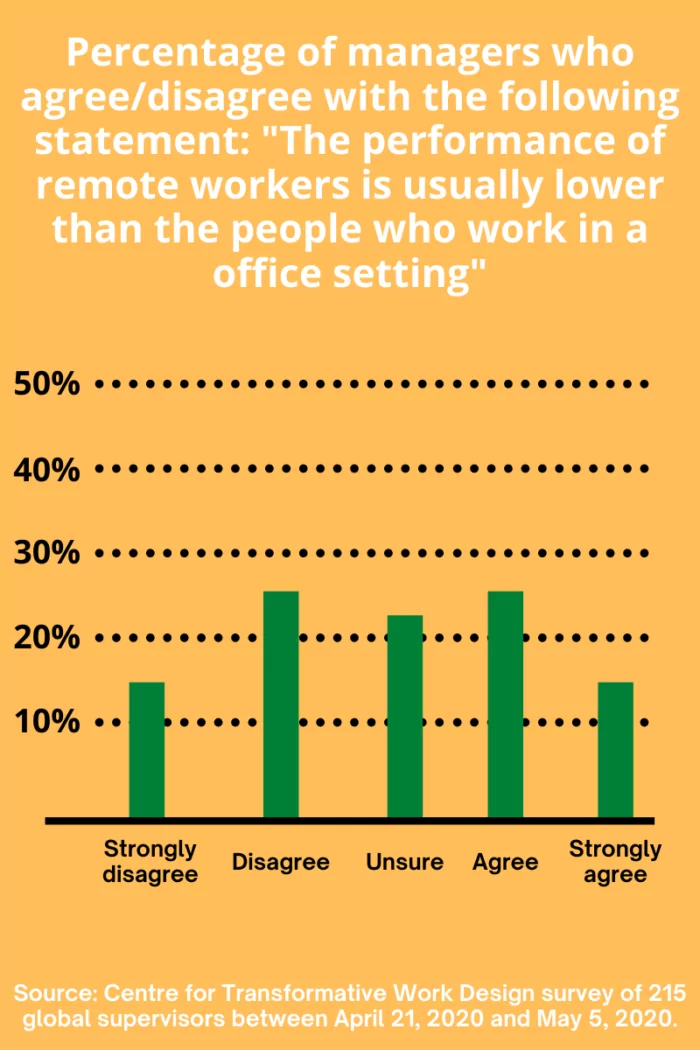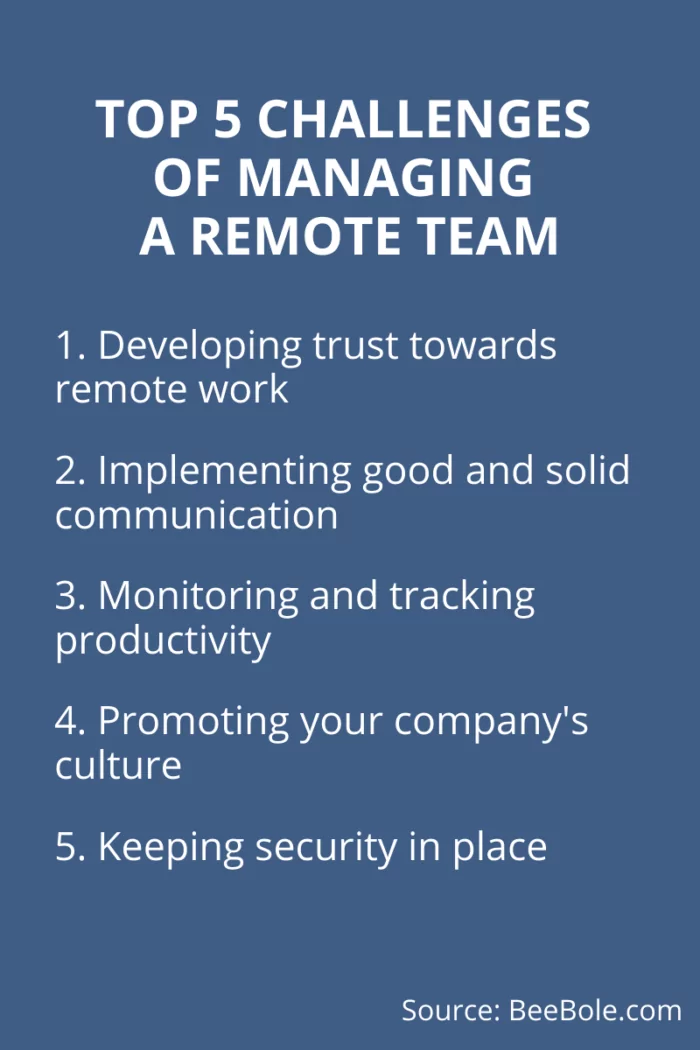The top 5 challenges of managing a remote team successfully

We live in times where, often, remote work is no longer an optional arrangement. Today, the question is not so much if but how to build a remote work strategy. However, the road that leads to a healthy remote work strategy can be bumpy if you’re not aware of the obstacles along the way. From developing trust towards remote work and remote employees to keeping security in place, the following are the top five challenges of managing a remote team successfully.
Most common remote work challenges for employees
Before jumping into the challenges of managing remote teams, it’s important to understand the issues that remote workers tend to complain about the most. Why? Because these issues can interfere with overall productivity and engagement levels, which is of course, bad for your company.
According to the 2020 State of Remote Work report elaborated by Buffer and AngelList, the following are remote workers’ biggest struggles:
- Collaboration and communication (20%)
- Loneliness (20%)
- Not being able to unplug (18%)
- Distractions at home (12%)
- Being in a different timezone than teammates (10%)
- Staying motivated (7%)
- Taking vacation time (5%)
- Finding reliable wifi (3%)
- Other (5%)
It’s important to keep this data in mind. Some of these issues are directly connected to some of the most common challenges that managers face when leading remote teams. Let’s take a look.
1. Developing trust towards remote work
The lack of trust towards remote work represents a big threat to your ability to successfully manage a remote team. Unfortunately, this attitude affects a significant number of managers. As stated by research conducted during Covid-19 by Harvard Business Review, “a substantial number of managers have low confidence in their capability to lead remotely, have rather negative views about this work practice, and distrust their own workers.”
The following image (based on a survey by The Centre for Transformative Work Design), gives us a glimpse of this:

Nearly 40% of managers believe that remote employees perform worse than on-site workers. Similarly, 22% of respondents were unsure about that statement. In other words, we can see a significant number of managers who don’t trust remote work.
If this resonates with you, developing trust towards remote work and employees might be the first challenge you face when building a remote work strategy. Without the right attitude and level of trust, the odds of managing a remote team successfully are significantly low.
2. Implementing good and solid communication
Even though we have many tools to stay connected digitally, communication is still a significant struggle for remote managers. The following are some of the most important communication challenges.
Lack of physical signals
In an office, interactions among people come with visual cues that help you understand other people’s communication boundaries and preferences. What’s the best way to communicate with a remote team when you don’t have those signals and cues? That’s one of the biggest challenges of managing a remote team, and one that every manager needs to face regardless of company size.
From micromanagement to overcommunication
Micromanagement is wrong in an office and even more so remotely. If you are used to regularly checking and monitoring people in your office, you might feel tempted to overcommunicate with your remote team. If you fall into that trap, you can expect to negatively affect employee productivity and engagement.
Different time zones and schedules
What happens when someone takes hours (or days) to respond to a message you’ve sent? Are some employees working in different time zones? These are important questions to ask, especially if you work for a big organization with employees spread across the world.
Cultural and background differences
Do you work with people from different countries or with different backgrounds? Do you understand their cultures and expectations? A limited vision of the diversity within your team creates the possibility for misunderstandings, which can negatively affect overall engagement.
This challenge, however, isn’t exclusive to global or transnational teams. In fact, it can also affect a small remote team located in the same city. If you don’t take into consideration different communication styles, personalities, and lifestyles, misunderstandings are likely to abound.
A feeling of exclusion
If you are planning to have a hybrid team (part of your team work in your office and part remotely), there is a good chance that your remote employees may feel excluded from your organization if you don’t communicate properly. For example, if you exclude your remote employees from the important conversations that take place around the office, you will be creating a gap and a system of preferences, which can severely harm your business and corporate culture.
Technical difficulties
Even if you are the best manager in the world, recurring technical problems can be just the ticket for communication difficulties. This problem is even worse if you have employees that fall into that 3% of people who identify “finding reliable wifi” as one of the biggest struggles of their remote work experience.
3. Monitoring and tracking productivity
Tracking the productivity of your team members when you are working in the same office is an easy thing to do. You just need to stand up and reach out to any member of your team in order to get updates about projects and tasks. However, managing a remote team is a totally different ball game.
How do you keep track of your remote team members’ productivity without micromanaging or breaching employee privacy? How do you prevent burnout from people tempted to overwork while remote? These are some of the questions you need to answer if you want to effectively and successfully track remote team productivity.
4. Promoting your company’s culture
Daily face-to-face interactions and the general atmosphere of an office are two elements that shape workplace culture, and obviously, they’re two variables missing from the remote work realm. The lack of these elements is often responsible for that “loneliness” that many remote employees identify with.
Promoting your company’s culture when some of the most important elements associated with it are absent represents one of the biggest challenges remote managers need to tackle.
5. Keeping security in place
From a technological point of view, security is a huge challenge when it comes to leading remote teams. In fact, numerous studies have warned about the lack of security training among newly remote employees as well as the significant numbers of cyberattacks against the corporate world after COVID-19.
A recent study by IBM, for instance, found out that 47% of newly remote employees were “concerned about impending cybersecurity risks.” Similarly, Bolster’s Q1 FY 2020 State of Phishing & Online Fraud reported a dramatic increase in cybercriminal activity. “Collaboration and communication phishing sites saw a 50% increase from January to March, as a large majority of the workforce began working from home,” stated the report.
This situation has been worsened by overall bad practices such as increased exposure to insecure wireless access points and a lack of basic encryption for data protection. Because of all this, enforcing security and data protection is another challenge of leading a remote team.

How to manage a remote team successfully
We strongly believe that these five areas represent the main sources of challenges when it comes to managing remote teams. There are, however, many more challenges you need to face when dealing with a virtual team. Those challenges include adjusting your company to new and updated remote work-related legislation, monitoring the overall well-being and psychological conditions of your remote team members, and providing smart solutions to employees who may need assistance to get organized while working from home.
Building a solid remote work strategy is a process that comes with many challenges. However, if you want to embrace success, it is crucial that you come up with solutions and strategies that help you to deal with the challenges mentioned throughout this article. If you are able to start there, you will be well on your way to creating a virtual space where you can establish and reach your goals with ease while fostering a healthy and dynamic environment that empowers employees and encourages high engagement.
—
Photo by Jason Strull on Unsplash
Related posts
How to build a successful and measurable remote work strategy
Published: 2021/3/4 | Carlos QuintanaWhether you’ve been managing a remote team for years or are newly embracing a remote-work model, knowing how to build ...
Is a great place to work compatible with remote work?
Published: 2021/10/5 | Carlos QuintanaWe are entering a new era where remote and hybrid-based models will likely prevail across the corporate world. Because of ...
5 challenges of mobile workforce management that companies will face in 2019: We asked the experts
Published: 2017/11/29 | Magda A. TorresThe rise of the concept Mobile Workforce is a tremendous example of how technology is transforming our personal and professional ...



